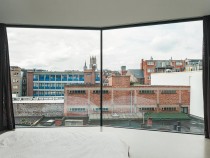
© Tim Van de Velde
The idea underlying this housing development, which the young architect designed for himself and his family, is based on a stack of angular glazed volumes set on an infill site only 5.50 m wide in the middle of a small-scale peripheral block development. Here, a garage had previously stood.
This was considerably lower in height than the adjoining buildings, and the existing construction was demolished apart from the ground floor which now forms the plinth of the new structure. The full height of the gap between the buildings has been exploited, so that space was created for a house with four storeys. These comprise the garage and entrance area on the ground floor; above this, the living realm
with an open kitchen; on the second floor, a bedroom and bathroom; and right at the top, a further bedroom with a large roof terrace.
In view of the poor load-bearing quality of the soil, the architect opted for a lightweight load- bearing structure, consisting of slender steel columns and I-girders complemented by timber beams in the floors.
The ingeneous design of the glazed facade of the three dwelling levels is contrasted with the closed, uniformly black plinth storey from the previous structure. Playfully offset to each other, the fully glazed, oblique lines of the end faces are cantilevered out somewhat. They might be regarded as a modern interpretation of the classical oriel.
This was considerably lower in height than the adjoining buildings, and the existing construction was demolished apart from the ground floor which now forms the plinth of the new structure. The full height of the gap between the buildings has been exploited, so that space was created for a house with four storeys. These comprise the garage and entrance area on the ground floor; above this, the living realm
with an open kitchen; on the second floor, a bedroom and bathroom; and right at the top, a further bedroom with a large roof terrace.
In view of the poor load-bearing quality of the soil, the architect opted for a lightweight load- bearing structure, consisting of slender steel columns and I-girders complemented by timber beams in the floors.
The ingeneous design of the glazed facade of the three dwelling levels is contrasted with the closed, uniformly black plinth storey from the previous structure. Playfully offset to each other, the fully glazed, oblique lines of the end faces are cantilevered out somewhat. They might be regarded as a modern interpretation of the classical oriel.




